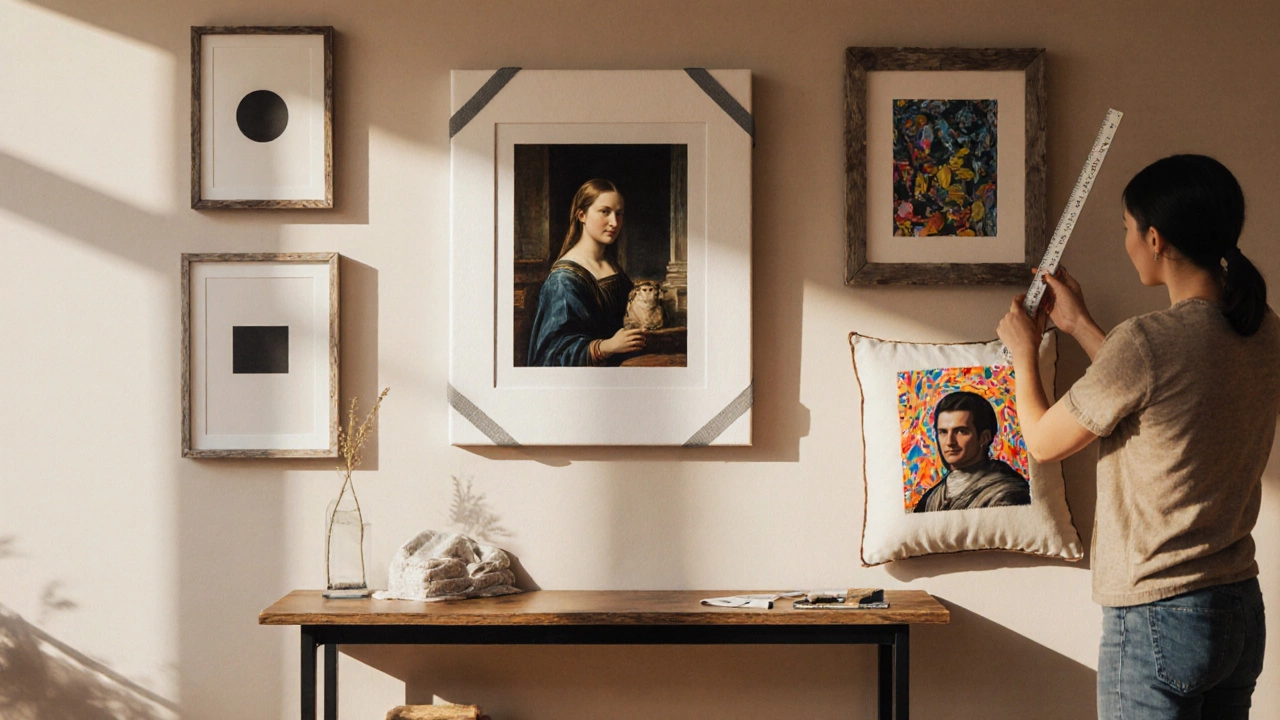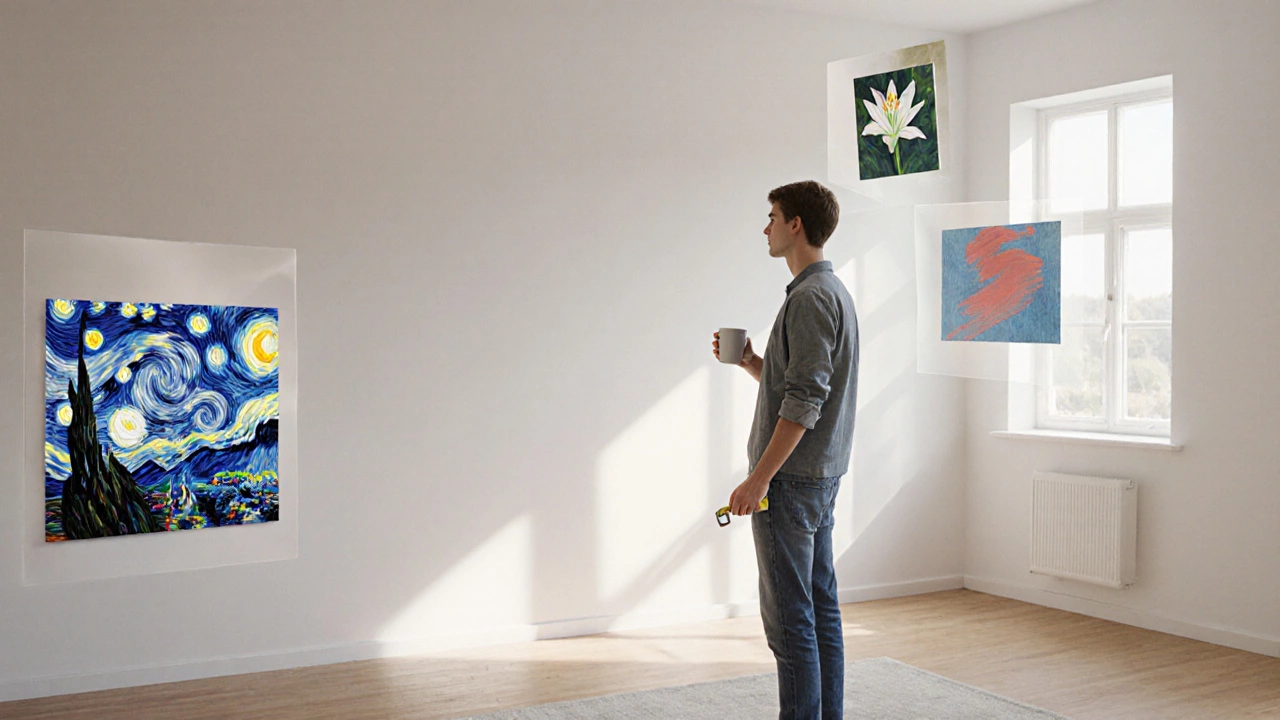Free Art License Checker
Verify what you can and cannot do with free paintings before printing or sharing. This tool helps you understand licensing requirements for common image sources.
License Requirements
What You Need to Do
Important Notes
Always check the specific source's usage policy before printing, as institutions sometimes add additional restrictions.
When in doubt, assume the image is not free for commercial use.
If you’ve ever stared at a blank wall and wished you could hang a beautiful painting without spending a dime, you’re not alone. The internet is full of resources that let you download, print, and display art for free-legally and in high quality. Below is a step‑by‑step guide that shows where to look, how to stay clear of copyright trouble, and the best ways to turn a digital file into a striking piece of wall art.
Why Free Paintings Are Worth Exploring
Free art isn’t just a cost‑saving hack. It gives you access to centuries‑old masterpieces, fresh indie creations, and niche subjects you might never find in a store. Plus, because you control the file, you can print it at any size, on any material, and even edit colors to match your décor.
Top Sources for Free Paintings
Below are the most reliable places to download high‑resolution paintings without paying a cent. Each source is marked up the first time it appears so search engines can recognize the entity.
-
Public domain paintings are works whose copyright has expired or never existed. Museums, libraries, and archives often host these files for public use.
- National Gallery of Art (Washington, D.C.) - download portal
- The MET Open Access - over 400,000 images, all CC0.
- Rijksmuseum - high‑resolution scans of Dutch Golden Age works.
-
Creative Commons art lets creators share work under specific licenses that often permit commercial or non‑commercial use with attribution.
- Flickr’s "The Commons" - filter by CC BY‑SA or CC0.
- Wikimedia Commons - thousands of paintings tagged with clear license info.
- Unsplash - a growing collection of modern paintings uploaded by artists under a generous license.
-
Museum digital collections often provide free downloads for educational or personal use.
- Victoria & Albert Museum (UK) - downloadable JPEGs up to 600 MP.
- Google Arts & Culture - high‑res zoom on masterpieces from over 2,000 institutions.
-
Free stock art sites specialize in modern illustrations and abstract paintings.
- Pexels - curated “paintings” collection.
- Freepik (free tier) - vector‑based art you can recolor.
-
Print‑on‑demand freebies are occasional promotions where companies give away ready‑to‑print files.
- Society6 - monthly free download for members.
- Redbubble - limited‑time free art bundles.
-
Local art swaps let you trade or receive donations from community artists.
- Melbourne Community Art Hub - free wall‑art evenings.
- Neighbourhood Facebook groups - often post “free art” offers.
How to Verify That an Image Is Truly Free
Before you hit “print,” double‑check the license. Here’s a quick checklist:
- Locate the license statement on the download page.
- Confirm it says CC0, Public Domain, or a Creative Commons license that allows commercial use (if you plan to sell prints).
- Make sure attribution requirements are clear; note the artist’s name and source.
- Look for any “no derivatives” clause-if present, you can’t crop or recolor the image.
If any of these steps raise doubt, skip the file or reach out to the author for permission.
Printing Your Free Painting: From Screen to Wall
Printing quality can make or break the final look. Follow these practical tips to get a museum‑grade result:
- Resolution matters: Aim for at least 300 dpi at the size you intend to print. Most public‑domain archives provide files at 600 dpi or higher.
- Choose the right paper: Matte archival paper mimics classic canvas, while glossy photo paper brings out vibrant colors for modern abstracts.
- Consider canvas printing: Many online printers (e.g., CanvasPop) accept high‑resolution JPEGs and stretch them over stretcher bars for a true‑painting feel.
- Color‑manage your monitor: Calibrate the screen so the colors you see match the printed output.
Comparison of Free Painting Sources
| Source | Typical Art Types | License | Max Resolution | Best For |
|---|---|---|---|---|
| Public domain museums | Classical, Renaissance, Impressionist | CC0 / Public Domain | 600 dpi+ (often 10 k+ pixels) | Large‑scale wall art, historic decor |
| Creative Commons platforms | Modern, illustration, abstract | CC BY, CC BY‑SA, CC0 | 300-600 dpi | Mix‑and‑match, DIY collages |
| Free stock art sites | Minimalist, vector‑based, digital paintings | Free tier license (often non‑commercial) | Up to 300 dpi | Contemporary office spaces |
| Print‑on‑demand freebies | Trend‑y, seasonal designs | Promotional, limited‑time free | 300 dpi | Quick décor swaps, gifting |
| Local art swaps | Hand‑made, community‑created | Varies - often donation‑based | Depends on artist | Neighborhood vibe, supporting locals |
Legal Pitfalls and How to Avoid Them
Even free resources can trip you up if you ignore the fine print. Here are the most common mistakes:
- Assuming all museum images are free: Some institutions allow only personal‑use downloads. Check the usage policy before printing for public display.
- Neglecting attribution: Creative Commons licences that require credit will force you to add a plaque or a small note near the frame.
- Mixing licenses in a single collage: If you blend a CC BY‑SA image with a CC0 piece, the whole work must follow the more restrictive BY‑SA terms.
- Commercial resale without permission: Printing a free image to sell as a poster usually needs a commercial‑use licence, not just a personal‑use one.
When in doubt, treat the image as “all rights reserved” and look for an alternative.

Creative Ways to Use Free Paintings
Once you have a few high‑quality files, the fun part begins. Try these ideas to make the most of your free art:
- Gallery wall: Mix three‑panel works with a single‑panel masterpiece for a curated look.
- Color‑swap: Use a free Photoshop brush set to shift hues and match your sofa.
- DIY frames: Upcycle reclaimed wood for a rustic frame that complements the painting’s era.
- Printed fabric: Turn a painting into a custom pillow cover or upholstered chair.
- Seasonal rotations: Swap a summer landscape for a winter scene every few months to keep your space fresh.
Step‑by‑Step: Download, Print, Hang
Putting it all together is easier than you think. Follow these seven steps for a hassle‑free experience:
- Choose a source from the list above and locate a painting you love.
- Read the license; note any attribution requirements.
- Download the highest‑resolution file (usually a .tiff or .jpeg).
- If needed, use a free editor like GIMP to crop or adjust colors.
- Save the final file as a 300 dpi PDF for printing.
- Send the PDF to a local print shop or an online canvas service.
- Measure your wall, choose a frame or canvas wrap, and hang with picture‑hanging strips.
That’s it-no budget, no guilt, just art that feels personal.
Frequently Asked Questions
Are public domain paintings really free to print?
Yes. When a work is in the public domain, anyone can reproduce, distribute, or modify it without asking for permission. Just double‑check the museum’s usage policy, as some institutions add extra restrictions for commercial projects.
Do I need to credit the artist for a CC0 image?
No. CC0 waives all rights, so you can use the image without attribution. It’s still good practice to mention the source if you share the image online.
Can I sell prints made from free paintings?
Only if the license permits commercial use. Public domain and CC0 images are fine. For Creative Commons licenses, look for CC BY or CC BY‑SA, which allow sales as long as you follow attribution and share‑alike rules.
What’s the best paper for a museum‑style print?
Archival matte paper (often labeled “fine art paper”) mimics the texture of canvas while preserving color fidelity. It’s acid‑free and resistant to yellowing.
How can I find local art‑swap events in Melbourne?
Check community boards at libraries, search Meetup.com for “art swap Melbourne,” and follow neighborhood groups on Facebook. Many councils also run free art‑exchange days in public parks.
Whether you’re decorating a first‑apartments, a home office, or a boutique hotel lobby, free paintings give you endless options without the price tag. Dive into the sources above, respect the licenses, and let your walls speak your style.


